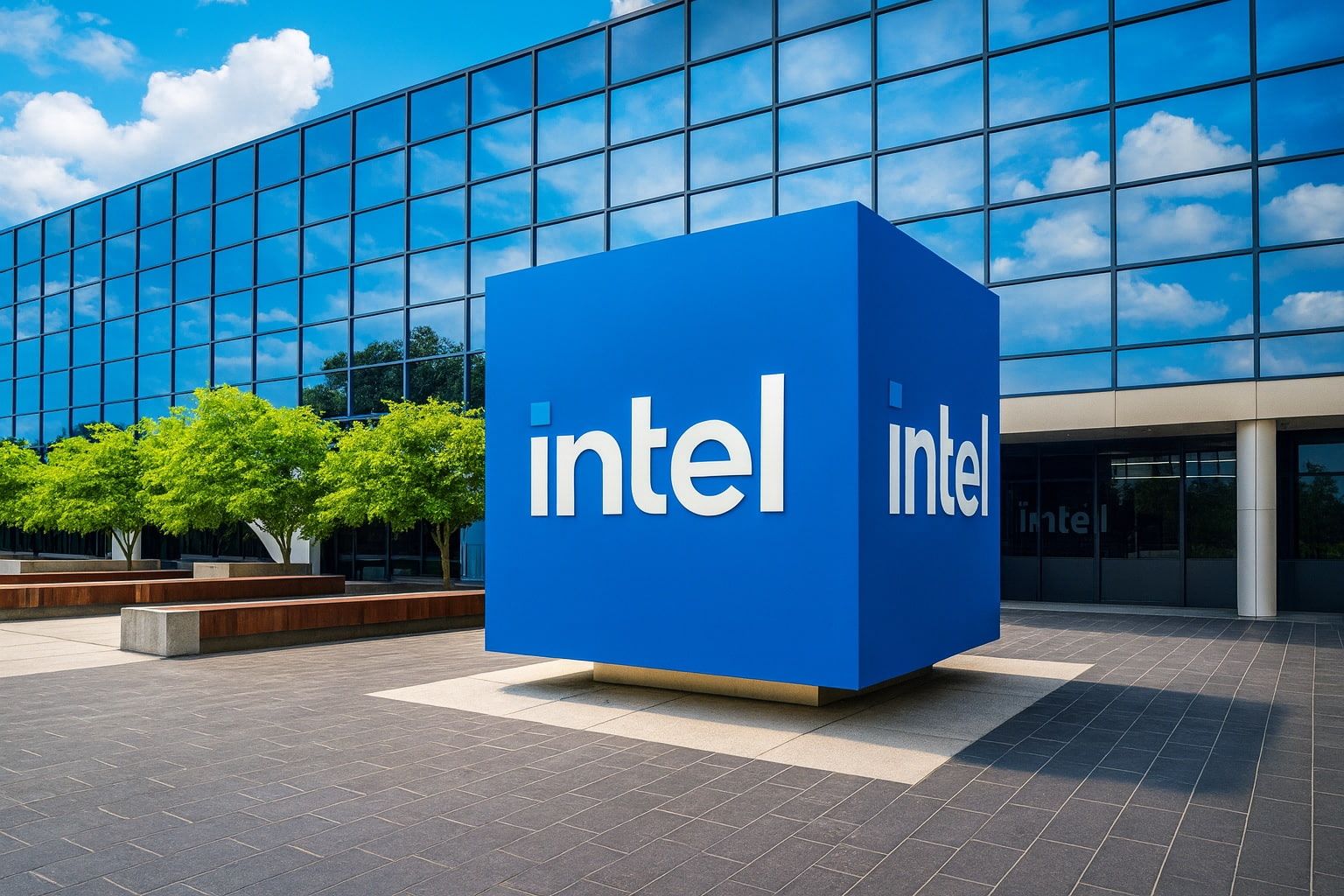Intel stock (NASDAQ: INTC) is under pressure on November 21, 2025 as investors react to trade‑secret allegations tied to TSMC, an aggressive new custom‑chip strategy in China, fresh analyst coverage from Raymond James, and institutional investors trimming positions. Here’s what it all means for Intel shareholders today
Intel stock price today (21 November 2025)
Intel shares are easing again in Friday trading.
- Latest price: around $33.30 per share, down roughly 1% on the day as of Friday afternoon.
- Thursday close referenced in several reports: about $33.62, already down sharply from recent levels. [1]
- 52‑week range: roughly $17.67–$42.48, putting today’s price about 20–25% below the October high, but still well above this year’s lows. [2]
MarketBeat data show Intel’s market capitalization sitting around $160 billion, with the stock now trading below its 50‑day moving average (~$35.42) but well above its 200‑day average (~$26.69). [3]
In other words: Intel is in pullback mode after a big 2025 rally, with today’s action shaped by three narratives:
- A trade‑secret controversy linked to TSMC.
- A strategic pivot to custom chips in China.
- A mixed Wall Street stance—including new “market perform” coverage from Raymond James and evidence of institutional profit‑taking.
1. Trade‑secret drama: Intel vs. TSMC rumor mill
The most attention‑grabbing Intel stock story today centers on alleged trade‑secret leakage from TSMC.
Reports out of Taiwan and the U.S. describe an investigation into Lo Wen‑jen, a long‑time senior executive at Taiwan Semiconductor Manufacturing Co. who recently joined Intel. Taiwan’s High Prosecutors Office and TSMC are probing whether confidential information left the company without authorization. [4]
Intel’s new CEO Lip‑Bu Tan, who took the top job in March 2025, has pushed back firmly on the allegations. In comments reported by Bloomberg and echoed in FX Leaders coverage, Tan said Intel “respects intellectual property” and rejected the suggestion that the company poached trade secrets via the hire. [5]
Despite the denial, sentiment took a hit:
- FX Leaders notes Intel shares fell about 4% to roughly $33 in the wake of the headlines, citing broader sector volatility and ongoing U.S.–China trade tensions as additional pressure points. [6]
- GuruFocus and other outlets highlighted the “shock accusation” as one of the reasons Intel featured prominently among the day’s most‑discussed chip stocks. [7]
For investors, the core risk here is not simply legal exposure—there’s no indication yet of wrongdoing by Intel—but reputational and geopolitical risk:
- Intel is already under intense scrutiny because of its foundry ambitions and government backing.
- Anything that smells like IP misappropriation from TSMC will be watched closely by regulators, customers and partners.
So far, markets seem to be pricing this as headline risk rather than existential risk—but it’s clearly one reason Intel stock is trading nervously into the weekend.
2. Intel doubles down on China with custom chips
While traders focus on TSMC headlines, one of the most strategically important developments today is Intel’s China pivot.
A new Caixin Global report outlines how Intel is intensifying its localization strategy in China, unveiling plans to offer custom chip solutions for the country’s PC and cloud‑computing markets—segments Intel expects to reach multi‑trillion‑yuan scale. [8]
Key points from Caixin’s coverage:
- At an Intel summit in Chongqing, Intel China chairman Wang Zhicong described a “menu‑style” modular manufacturing model, where Chinese customers can specify configurations and Intel tailors chips to those needs. [9]
- China accounted for around 29% of Intel’s global revenue in 2024 (~$15.5 billion), underlining why the company cannot ignore this market even as U.S. export controls tighten. [10]
- The move comes against the backdrop of China’s “Xinchuang” (information innovation) initiative, which aims to replace foreign technology in critical infrastructure. Local chipmakers such as Hygon, HiSilicon and Phytium are steadily improving and are mentioned as rising competitors to Intel and AMD. [11]
Why this matters for the stock:
- Bullish angle: Custom chips can strengthen Intel’s grip on Chinese OEMs and cloud players, defend share in PCs and servers, and open up higher‑margin design work if executed well.
- Bearish angle: The strategy amplifies geopolitical risk. U.S. lawmakers are already pushing to tighten conditions on CHIPS Act subsidies and curb certain China‑related imports by subsidy recipients. [12] Intel must walk a tightrope between Chinese revenue growth and U.S. national‑security politics.
For now, investors are digesting this as a long‑term strategic bet, not an immediate earnings event—but it feeds directly into how Wall Street models Intel’s future growth and risk profile.
3. Foundry pivot under fire: Citi’s skepticism and foundry losses
On top of the China news, a widely shared analysis today highlights Citi’s increasingly skeptical stance on Intel’s foundry transformation.
A report summarized by Ad hoc news notes that:
- Intel’s ambitious “five nodes in four years” roadmap and its push to build a contract manufacturing (foundry) business are proving tougher than many bulls hoped.
- Citi expects only limited wafer‑manufacturing wins in the near term, with a large share of Intel Foundry Services revenue likely coming from advanced packaging rather than full leading‑edge wafer production. [13]
- The foundry business is estimated to be running at an operating loss of around $2.3 billion in 2025, making the path to breakeven longer and more uncertain. [14]
Technically, the same report points out that Intel shares have dropped more than 15% from their recent high near the equivalent of $42–43, slipping below key moving averages and testing support in the low‑$30s. [15]
The takeaway: Intel’s foundry pivot remains the core long‑term story, but the numbers still look painful, and skeptical research notes like Citi’s add to short‑term pressure whenever the stock rallies too far, too fast.
4. Earnings backdrop: from deep loss to fragile profitability
Under CEO Lip‑Bu Tan, Intel has swung from massive losses to modest profitability—but the quality and sustainability of that profit are under debate.
Two different lenses are prominent in coverage today:
- Headline GAAP turnaround.
- AP reports Intel posted net income of about $4.1 billion, or $0.90 per share, for the quarter ended September 2025, versus a $17 billion loss a year earlier, on revenue of roughly $13.7 billion, up 3% year‑on‑year. [16]
- The quarter was also the first since the U.S. government took a 10% stake in Intel, as part of a CHIPS Act national‑security package that channelled nearly $9 billion in government funding and additional billions from partners like Nvidia and SoftBank. [17]
- Analyst‑model view (Zacks & MarketBeat).
- Zacks, via a Finviz‑hosted note, focuses on an adjusted EPS figure of $0.23 on revenue of $13.65 billion, both beating consensus estimates and marking a return to positive earnings versus ‑$0.46 EPS a year ago. [18]
- The firm highlights that Intel beat EPS estimates in three of the last four quarters and revenue estimates in all four, but still expects current‑quarter EPS of just $0.07 and full‑year EPS of $0.32—a big improvement year‑on‑year, but far from pre‑slump levels. [19]
- MarketBeat notes management has set Q4 2025 guidance at about $0.08 EPS, and that the analyst community still expects roughly ‑$0.11 EPS for the full fiscal year on a GAAP basis once restructuring and other charges are factored in. [20]
Add in restructuring:
- Reporting from Tom’s Hardware and others shows Intel has already cut more than 35,000 jobs in under two years, with around 20,500 departures in the three months after Tan became CEO, as the company slashed R&D in some areas and doubled down on AI and advanced process nodes like Intel 18A and 14A. [21]
Net result: Intel is profitable again, but just barely, and much of the profit story is intertwined with government support, deep cost‑cutting, and an aggressive but risky manufacturing turnaround.
5. Wall Street today: Raymond James coverage, consensus “Reduce,” and heavy institutional ownership
A fresh MarketBeat instant alert today details new analyst coverage and the broader Street view:
- Raymond James has initiated coverage of Intel with a “market perform” rating, effectively a neutral stance. [22]
- Across the Street, MarketBeat counts 2 Buy ratings, 24 Holds, and 8 Sells, leading to a consensus rating of “Reduce” and an average price target of $34.84—only slightly above where the stock trades today. [23]
At the same time, Zacks notes that Intel is one of the most heavily searched tickers on its platform right now and assigns the stock a Zacks Rank #3 (Hold) with a Value Style Score of “D”, indicating it screens as relatively expensive versus peers on traditional valuation metrics. [24]
Institutional moves: trimming into strength
Two separate MarketBeat filings stories published today show some institutions taking profits:
- Wealthspire Advisors LLC cut its Intel stake by 51.8% in Q2, selling about 60,700 shares and ending the quarter with roughly 56,600 shares worth $1.27 million. [25]
- Empowered Funds LLC trimmed its position by 46.9%, to around 259,800 shares valued at $5.82 million, after selling roughly 229,000 shares in the same period. [26]
However, other big players have moved in the opposite direction:
- MarketBeat’s coverage notes that Vanguard, State Street, Geode, Capital World, Price T Rowe, Goldman Sachs and Assenagon have all increased or initiated sizeable positions, bringing institutional ownership to about 64.5% of Intel’s float. [27]
In short, smart money is actively rotating around Intel: some managers are locking in gains after the stock’s big rebound, while others are building long‑term positions at current levels.
6. What the models say: fair value ranges and scenario analysis
A Simply Wall St valuation piece out today (surfacing on Google Discover in many geographies) frames Intel through two scenarios. [28]
- In its bullish scenario, the platform estimates a fair value around the high‑$30s per share, arguing that:
- Revenue could grow by around 5–6% annually as Intel refocuses on AI, data‑center silicon, and its foundry business.
- The market is underestimating the long‑term payoff from U.S. government backing and a regained manufacturing edge.
- In a more bearish scenario, it models fair value in the high‑$20s, assuming:
- Intel struggles to secure large, high‑margin external foundry customers beyond packaging.
- Competition from Nvidia, AMD and Chinese chipmakers compresses pricing power.
With Intel trading in the low‑$30s, the message from these models is that the stock now sits between fair‑value and mildly overvalued depending on your assumptions. There’s upside if Tan’s turnaround delivers, but not a clear deep‑value discount.
7. Key risks and catalysts to watch after today
Looking beyond Friday’s tape, here are the main forces likely to move Intel stock over the next few months:
1. Outcome of the TSMC‑related investigations
If Taiwan’s prosecutors or TSMC find evidence that trade secrets were taken, it would significantly raise legal and reputational risk. Conversely, a clean outcome would clear an overhang that’s currently amplifying volatility. [29]
2. China strategy vs. U.S. policy
Intel’s custom‑chip push in China must stay within tightening U.S. export‑control and CHIPS‑Act rules. Any new restrictions on what CHIPS recipients can do in China—or Chinese retaliation—could directly affect the growth Intel is targeting in that multi‑trillion‑yuan market. [30]
3. Foundry wins (or misses)
Investors will be watching:
- Does Intel announce large external wafer customers beyond packaging deals?
- Do foundry operating losses begin to shrink from the ~$2.3 billion level cited in recent estimates, or do they widen? [31]
4. Next earnings and guidance (Q4 2025 / early 2026)
Street expectations are modest:
- Zacks sees Q4 EPS near $0.07 and revenue down about 6% year‑on‑year. [32]
- MarketBeat notes management’s $0.08 EPS guidance and consensus for slightly negative full‑year EPS on a GAAP basis. [33]
Any surprise—positive or negative—around margins, capex, or foundry progress could trigger a meaningful move.
5. AI leadership and talent
Last week’s news that Intel’s top AI executive Sachin Katti is leaving to join OpenAI, with Tan personally assuming oversight of AI and advanced technologies, underscores both Intel’s commitment to AI and its struggles to retain star talent. [34]
If Intel can ship competitive data‑center AI accelerators and secure high‑profile AI customers, today’s skepticism may fade. If not, the narrative of Intel “missing the AI wave” will persist.
8. Is Intel stock a buy, sell, or hold after today’s news?
Nothing in markets is unanimous—but today’s composite message from price action, analysts and fundamentals looks like this:
- Price: Intel trades just below the Street’s average target (~$34.84) and well off its recent high, suggesting limited near‑term upside unless new positive catalysts emerge. [35]
- Analysts: Consensus is effectively “Hold to Underweight” (Zacks Hold, MarketBeat “Reduce,” Raymond James “market perform”). [36]
- Story: The turnaround is real (back to profit, big AI and foundry push, China localization), but execution risk is high, and the foundry segment is still burning significant cash. [37]
For more aggressive, long‑term investors, Intel today looks like a high‑beta turnaround bet:
- Upside if Tan’s restructuring, government backing, and foundry push succeed, and if custom China chips become a durable profit engine.
- Downside if AI products remain uncompetitive, foundry losses balloon, or geopolitics sharply constrain China growth.
For more conservative investors, the case for waiting is straightforward:
- The stock is not obviously cheap on most valuation screens relative to peers. [38]
- Earnings are still thin, guidance is cautious, and consensus price targets offer only modest upside from today’s level. [39]
Final word
As of November 21, 2025, Intel stock sits at the intersection of headline risk (TSMC allegations), strategic ambition (China custom chips, AI, foundry) and cautious Wall Street sentiment. For now, the market seems to be saying:
“Show us the execution before we pay a growth multiple again.”
This article is for information and education only and does not constitute financial advice. Always do your own research or consult a licensed financial adviser before making investment decisions.
References
1. www.marketbeat.com, 2. www.marketbeat.com, 3. www.marketbeat.com, 4. www.fxleaders.com, 5. www.fxleaders.com, 6. www.fxleaders.com, 7. finviz.com, 8. www.caixinglobal.com, 9. www.caixinglobal.com, 10. www.caixinglobal.com, 11. www.caixinglobal.com, 12. finviz.com, 13. www.ad-hoc-news.de, 14. www.ad-hoc-news.de, 15. www.ad-hoc-news.de, 16. apnews.com, 17. apnews.com, 18. finviz.com, 19. finviz.com, 20. www.marketbeat.com, 21. www.tomshardware.com, 22. www.marketbeat.com, 23. www.marketbeat.com, 24. finviz.com, 25. www.marketbeat.com, 26. www.marketbeat.com, 27. www.marketbeat.com, 28. simplywall.st, 29. www.fxleaders.com, 30. www.caixinglobal.com, 31. www.ad-hoc-news.de, 32. finviz.com, 33. www.marketbeat.com, 34. www.ft.com, 35. www.marketbeat.com, 36. www.marketbeat.com, 37. apnews.com, 38. finviz.com, 39. www.marketbeat.com







